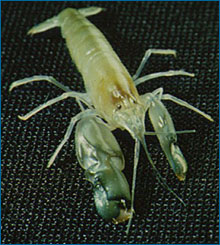
Mantis shrimp are not the only crustaceans with a fast and deadly foreleg. Snapping shrimp (a true shrimp) are armed with a powerful claw, which they use in an unusual way. When prey is nearby, the shrimp snaps its out-sized claw shut — but the claw doesn’t actually close on the intended victim. Instead, the snap is so powerful that it forms a bubble. The collapse of the bubble sends a shock wave through the water that stuns or kills the shrimp’s prey. And, surprisingly, the reverse-pop of the bubble makes a snapping noise loud enough to disrupt underwater communication and generates a flash of light. The researchers who discovered this underwater light show gave the phenomenon a flashy name: shrimpoluminescence.
